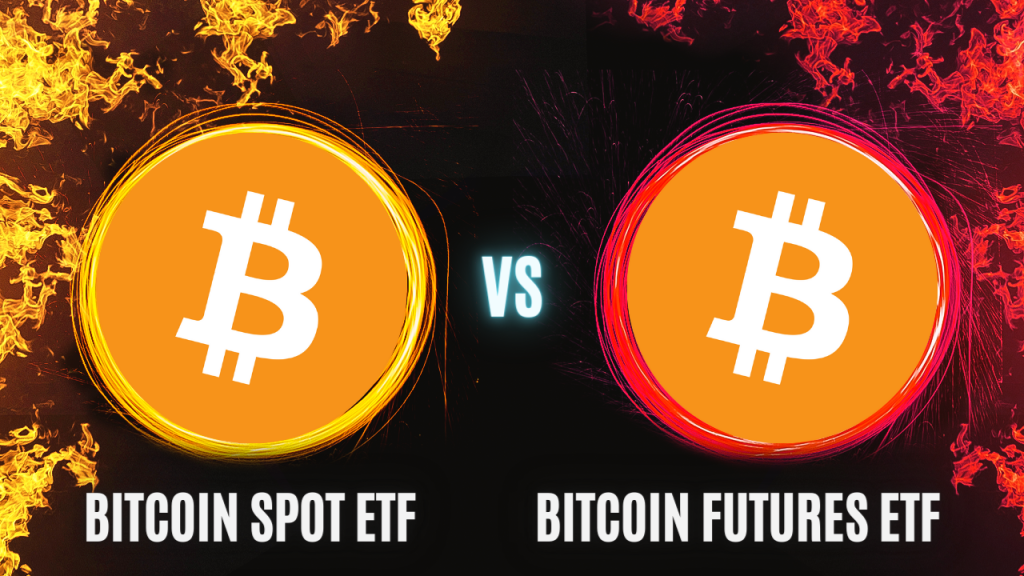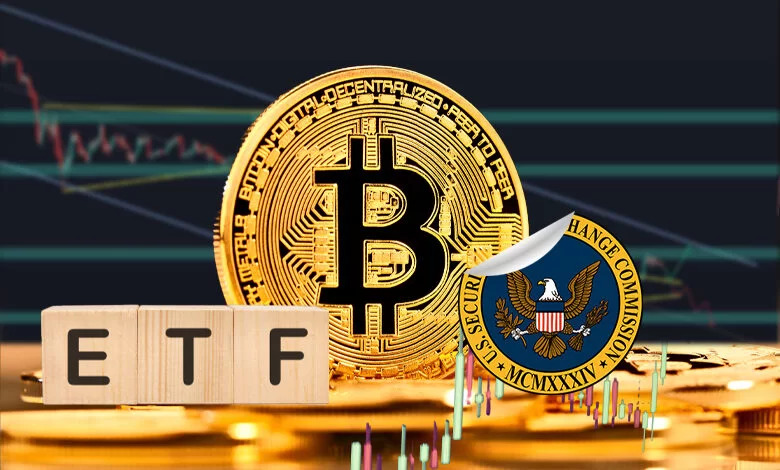Discover what Bitcoin ETF is, a simple way for everyone to invest in cryptocurrencies. Just like a regular ETF makes investing in a bunch of stocks easy, a Bitcoin ETF lets you invest in Bitcoin without the complex tech or trading stuffs.
What is a Bitcoin ETF?
A Bitcoin ETF, or Bitcoin Exchange-Traded Fund, is like a bridge that connects two worlds: the traditional stock market and cryptos. Imagine a regular ETF which you might already know. This investment type sticks together different stocks or assets, making it easier for you to invest at once instead of picking each stock one by one. A Bitcoin ETF is the same but all about Bitcoin and other cryptos.
When you buy a Bitcoin ETF, you’re not buying BTC directly. Instead, you’re investing in a fund that owns those coins. This ETF trades on regular stock exchanges – the same places where you’d buy and sell stocks. This makes Bitcoin ETFs a familiar and accessible way for people without understand complex things like crypto wallet.
It’s important to remember that a Bitcoin ETF reflects the price of Bitcoin, so if Bitcoin’s price goes up or down, the value of the Bitcoin ETF follows. This way, it offers a more straightforward route for investors who want exposure to the BTC’s price movements without owning the actual cryptocurrency.
How Do Bitcoin ETFs work?
Think of a Bitcoin ETF as your proxy in the world of Bitcoin. It’s like having a representative that deals with Bitcoin on your behalf. Here’s how it plays out: A financial company creates the ETF by buying a substantial amount of Bitcoin. This Bitcoin forms the core of the ETF. The company then splits this core into smaller, manageable parts, which are what you buy as shares.
When you invest in a Bitcoin ETF you’re buying shares that represent a piece of the Bitcoin held by the ETF. So you doesn’t invest in Bitcoin directly. These shares are traded on traditional stock exchanges. You can buy and sell them through your standard investment account.
The value of your investment moves in sync with Bitcoin’s market price. If the price of Bitcoin goes up, your ETF shares climb too. But if Bitcoin’s price drops, your ETF shares drop as well. This connection gives you a way to gain exposure to Bitcoin’s price volatility without directly handling your cryptocurrency.
For many, this is a convenient and less intimidating entry into Bitcoin. You don’t need to learn about cryptocurrency exchanges or secure a digital wallet. It’s a straightforward, familiar method to invest in Bitcoin, providing a safe and regulated way to explore the potential of this digital currency.
Difference Between a Bitcoin Futures ETF and a Bitcoin Spot ETF
There are two types of Bitcoin ETFs: Bitcoin Futures ETFs and Bitcoin Spot ETFs. Each has unique way to connect you to Bitcoin.

Bitcoin Futures ETF
A Bitcoin Futures ETF deals with ‘futures contracts’ of Bitcoin. These are not direct pieces of Bitcoin but agreements to trade Bitcoin at a set price in the future. It’s like making a bet on what Bitcoin will be worth later, without actually holding any Bitcoin today. This ETF is more about guessing Bitcoin’s future price than owning the currency.
ProShares Bitcoin Strategy ETF is the first Bitcoin Futures ETF, made its debut on the New York Stock Exchange (NYSE) on October 19, 2021, under the ticker symbol “BITO”.
Bitcoin Spot ETF
A Bitcoin Spot ETF, in contrast, involves buying real BTCs. When you invest in this ETF, you’re indirectly own a piece of Bitcoin, as the ETF holds the actual cryptocurrency. The value of your investment moves directly with BTC’s live market price. It’s a more straightforward way of getting into Bitcoin.
The first Bitcoin spot ETF was created by Canadian investment firm Purpose Investments. The ETF is called the Purpose Bitcoin ETF (BTCC) and was listed on the Toronto Stock Exchange (TSX) on 18 October 2023.
Key Differences
- Type of Investment: Spot ETFs mean you own actual Bitcoin(s), while futures ETFs are like placing bets on Bitcoin’s future value.
- Price Connection: Spot ETFs reflect Bitcoin’s real-time price. Futures ETFs, however, are tied to predicted future prices, which can be quite different, as they’re based on speculative forecasts rather than current market values.
- Risk Levels: Futures ETFs can be riskier and more complex due to the nature of futures trading, while spot ETFs are straightforwardly linked to Bitcoin’s current market performance.
Are Bitcoin ETFs Regulated? – The SEC Case
The answer is yes, any Bitcoin-linked ETF like Bitcoin Futures ETFs are regulated. For example in the U.S. they are regulated by the SEC (Securities and Exchange Commission). SEC been hesitant in approving spot Bitcoin ETFs.

As of late 2023, there are nine applications for spot Bitcoin ETFs pending SEC approval. Following a significant decision in the Grayscale case, which criticized the SEC’s position, there’s renewed hope for approval of these ETFs. The SEC has extended deadlines for several applications, with a notable eight-day window for approval of all 12 spot Bitcoin ETF applications. Analysts predict a 90% chance of at least one spot Bitcoin ETF approval by January 10, 2024.
UPDATE (3/25/2024): The SEC has approved 11 Bitcoin Spot ETFs on 10th of March, 2024. If you need more information, JUMP to our article.
BlackRock
Here we have to mention the most waited case about crypto ETFs. The world’s largest asset manager, BlackRock moved in the crypto scene in November 2023, when they filed applications for spot Bitcoin and Ethereum ETFs. At the time of writing, there’s no decision about the approval, however the SEC has to do it until March 15, 2024. If BlackRock’s application would be accepted, that would be a huge milestone! The company believes that ETFs can provide a more accessible and convenient way for investors to gain exposure to the crypto market.
Pros and Cons of Bitcoin ETFs
When it comes to investing in Bitcoin ETFs, like everything else, there are upsides and downsides. Let’s explore them:
Pros:
- Ease of Investment: Buying a Bitcoin ETF is like buying any other stock. You can do it without the knowledge of cryptos or worrying about digital wallet security.
- Regulated Environment: Bitcoin ETFs are regulated so it provides a layer of safety and legitimacy compared to buying Bitcoin directly.
- Lower Risk of Loss: Since you don’t hold Bitcoin directly, there’s less risk of losing your investment through theft or a lost digital wallet.
- Familiarity for Traditional Investors: For those used to stock market investing, Bitcoin ETFs offer a familiar way to invest in the crypto space.
Cons:
- No Direct Bitcoin Ownership: With a Bitcoin ETF, you don’t own actual Bitcoin, so you miss out on some benefits like using it for transactions or holding it as a digital asset.
- Fees: Bitcoin ETFs come with management fees, which can eat into your investment returns over time.
- Limited Control and Flexibility: You have less control over your investment compared to directly owning Bitcoin. For example, you can’t decide to move your Bitcoin to a different wallet.
- Market Hours Limitation: Since ETFs are traded like stocks, you’re limited to trading during market hours, unlike Bitcoin, which can be traded 24/7.
Invest in Bitcoin ETFs and How to Buy Bitcoin ETF?
The Bitcoin futures exchange-traded fund allowed to be traded on traditional exchanges instead of any crypto exchange. So to buy or sell these investments a little bit different. But here’s an easy follow step by step guide:
- Set Up a Brokerage Account: You need a brokerage account to buy and sell ETFs. Choose a trusted platform with low fees. New York Stock Exchange (NYSE) or Nasdaq could be a good choice.
- Research Different Bitcoin ETFs: Before investing, look at the Bitcoin ETF’s performance, fees, and whether they invest directly in Bitcoin or in related assets.
- Place Your Order: Log into your brokerage account, find the ETF using its ticker symbol, and place your order. You can buy a set number of shares or invest a specific amount.
- Monitor Your Investment: Keep an eye on your ETF. The value will change with Bitcoin’s price, so expect some fluctuations. Set up alerts in your brokerage account for major price movements.
- Think Long-Term: Bitcoin investments can be volatile. A long-term strategy can help you manage the ups and downs more effectively.
- Stay Updated: Always do your research and follow the news related to the crypto market and regulatory.
Investing in a Bitcoin ETF can be a comfortable way to enter the Bitcoin market. It’s less complex than buying Bitcoin directly but still offers exposure to its price movements. As with any investment, there’s risk involved, so invest wisely.
Featured image source: financemagnates




